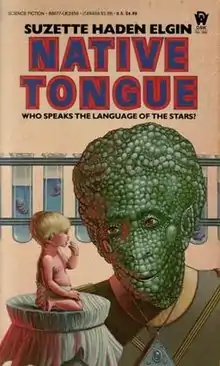Native Tongue (Elgin novel)
Native Tongue is a feminist science fiction novel by American writer Suzette Haden Elgin, the first book in her series of the same name. The trilogy is centered in a future dystopian American society where the 19th Amendment was repealed in 1991[1] and women have been stripped of civil rights. A group of women, part of a worldwide group of linguists who facilitate human communication with alien races, create a new language for women as an act of resistance. Elgin created that language, Láadan, and instructional materials are available.
 First edition | |
| Author | Suzette Haden Elgin |
|---|---|
| Cover artist | Jill Bauman |
| Country | United States |
| Language | English |
| Series | Native Tongue |
| Genre | Science fiction |
| Publisher | DAW Books |
Publication date | 1984 |
| Media type | Print (hardback & paperback) |
| Pages | 320 |
| ISBN | 0-87997-945-3 |
| OCLC | 44270270 |
| 813/.54 21 | |
| LC Class | PS3555.L42 N38 2000 |
| Followed by | The Judas Rose |
Plot summary
Native Tongue follows Nazareth, a talented female linguist in the 22nd century – generations after the repeal of the 19th Amendment. Nazareth is part of a small group of linguists "bred" to become perfect interstellar translators.[2]
Nazareth looks forward to retiring to the Barren House – where women past childbearing age go as they wait to die – but learns that the women of the Barren Houses are creating a language to help them break free of male dominance.
Reception
Elgin has said about the book:
Native Tongue was a thought experiment, with a time limit of ten years. My hypothesis was that if I constructed a language designed specifically to provide a more adequate mechanism for expressing women's perceptions, women would (a) embrace it and begin using it, or (b) embrace the idea but not the language, say "Elgin, you've got it all wrong!" and construct some other "women's language" to replace it. The ten years went by, and neither of those things happened; Láadan got very little attention, even though SF3 actually published its grammar and dictionary and I published a cassette tape to go with it. Not once did any feminist magazine (or women's magazine) ask me about the language or write a story about it.
The Klingon language, which is as "masculine" as you could possibly get, has had a tremendous impact on popular culture—there's an institute, there's a journal, there were bestselling grammars and cassettes, et cetera, et cetera; nothing like that happened with Láadan. My hypothesis therefore was proved invalid, and the conclusion I draw from that is that in fact women (by which I mean women who are literate in English, French, German, and Spanish, the languages in which Native Tongue appeared) do not find human languages inadequate for communication.[3]
Adaptations
Until Media acquired the rights to the trilogy and are currently producing a screen adaptation.[4]
See also
- Nü Shu, the Chinese system of women's writing
- The Handmaid's Tale, a dystopic speculative fiction novel by Margaret Atwood
- The Languages of Pao, science fiction novel in which manipulation of language is used to shape a civilization
References
- Native Tongue First Printing 1984, p 7
- "Native Tongue at The Feminist Press". Archived from the original on 19 April 2012. Retrieved 30 September 2011.
- Glatzer, Jenna (2007). "Interview With Suzette Haden Elgin". Archived from the original on 2007-06-12. Retrieved 20 March 2007.
- "HOME". www.untilmedia.com. Retrieved 2018-04-29.
Sources
- Mohr, Dunja M. Worlds Apart: Dualism and Transgression in Contemporary Female Dystopias. Jefferson, NC, McFarland, 2005. [extensive chapter on the Native Tongue Series]
Interview With Suzette Haden Elgin @ Womenwriters.net. 1999. https://web.archive.org/web/20120205054437/http://www.womenwriters.net/editorials/hadenelgin.htm
External links
- Native Tongue trilogy homepage
- Láadan language
- Native Tongue title listing at the Internet Speculative Fiction Database
- "We have always spoken Panglish" (Panglish appears in Native Tongue)